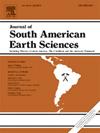Climatic, anthropogenic and sea level influences on the vegetation landscape of a lagoonal system, over the last 3350 years
IF 1.7
4区 地球科学
Q3 GEOSCIENCES, MULTIDISCIPLINARY
引用次数: 0
Abstract
This study explores the influence of dry and wet weather events, sea-level fluctuations, and anthropogenic activities on vegetation dynamics over the past 3,350 cal years BP. Sedimentological and palynological analyses were supported by radiocarbon (14C) and lead-210 (210Pb) dating of a 110 cm sediment core (GAR 1) extracted from the northwest sector of the Garzón Lagoon, Uruguay. Lagoon is an intermittently closed system, periodically opening to the sea, with a maximum depth of 5 m. Two different time windows are presented: part of the late Holocene and the last 150 years. Between 3,350 and 2,345 cal years BP, sea levels were high, and the lagoon maintained a broad connection to the sea, favoring halophytic vegetation, including Amaranthaceae and Poaceae, indicative of a salt marsh environment. After 2,345 cal yr BP, an increase in freshwater algae Botryococcus spp., resulting from a brief eutrophication episode, and a pronounced rise in arboreal taxa, particularly the Moraceae/Urticaceae group, signaled a shift towards a more freshwater-influenced system. The contemporary period (1841–2021 CE) is marked by pronounced climatic variability, alternating wet and dry episodes, and intensified anthropogenic activities, including Pinus spp. afforestation and expanded agricultural practices. These human interventions significantly impacted sedimentation rates and influenced the Garzón lagoon's ecological dynamics.
过去3350年来,气候、人为和海平面对泻湖系统植被景观的影响
本研究探讨了过去3350 cal BP干湿天气事件、海平面波动和人类活动对植被动态的影响。沉积学和孢粉学分析采用放射性碳(14C)和铅-210 (210Pb)定年方法,对乌拉圭Garzón泻湖西北部提取的110 cm沉积物岩心(GAR 1)进行测年。泻湖是一个间歇性封闭的系统,周期性地向大海开放,最大深度为5米。提出了两个不同的时间窗口:部分晚全新世和最近150年。在3350 - 2345 cal years BP之间,海平面较高,泻湖与海洋保持着广泛的联系,有利于盐生植物,包括苋科和禾本科,表明盐沼环境。在2345 cal yr BP之后,由于短暂的富营养化,淡水藻类bottryococcus spp的增加,以及树木分类群(特别是Moraceae/荨麻科)的显著增加,标志着向更多受淡水影响的系统的转变。当代(公元1841-2021年)的特点是气候显著变率,干湿交替,人类活动加剧,包括松树造林和农业实践的扩大。这些人为干预显著影响了沉积速率,并影响了Garzón泻湖的生态动态。
本文章由计算机程序翻译,如有差异,请以英文原文为准。
求助全文
约1分钟内获得全文
求助全文
来源期刊

Journal of South American Earth Sciences
地学-地球科学综合
CiteScore
3.70
自引率
22.20%
发文量
364
审稿时长
6-12 weeks
期刊介绍:
Papers must have a regional appeal and should present work of more than local significance. Research papers dealing with the regional geology of South American cratons and mobile belts, within the following research fields:
-Economic geology, metallogenesis and hydrocarbon genesis and reservoirs.
-Geophysics, geochemistry, volcanology, igneous and metamorphic petrology.
-Tectonics, neo- and seismotectonics and geodynamic modeling.
-Geomorphology, geological hazards, environmental geology, climate change in America and Antarctica, and soil research.
-Stratigraphy, sedimentology, structure and basin evolution.
-Paleontology, paleoecology, paleoclimatology and Quaternary geology.
New developments in already established regional projects and new initiatives dealing with the geology of the continent will be summarized and presented on a regular basis. Short notes, discussions, book reviews and conference and workshop reports will also be included when relevant.
 求助内容:
求助内容: 应助结果提醒方式:
应助结果提醒方式:


